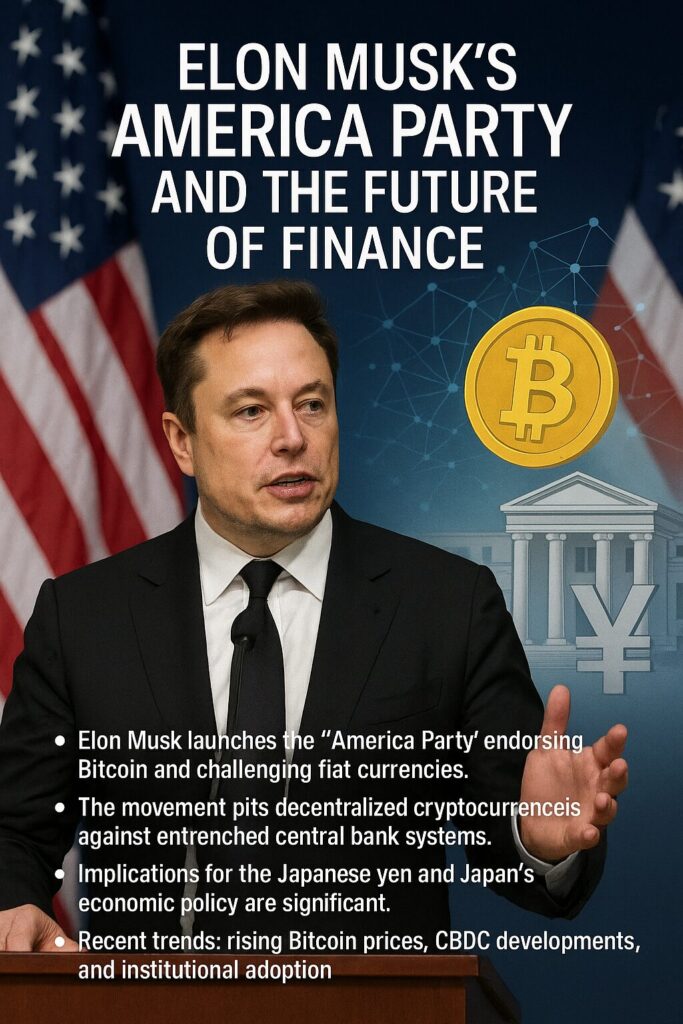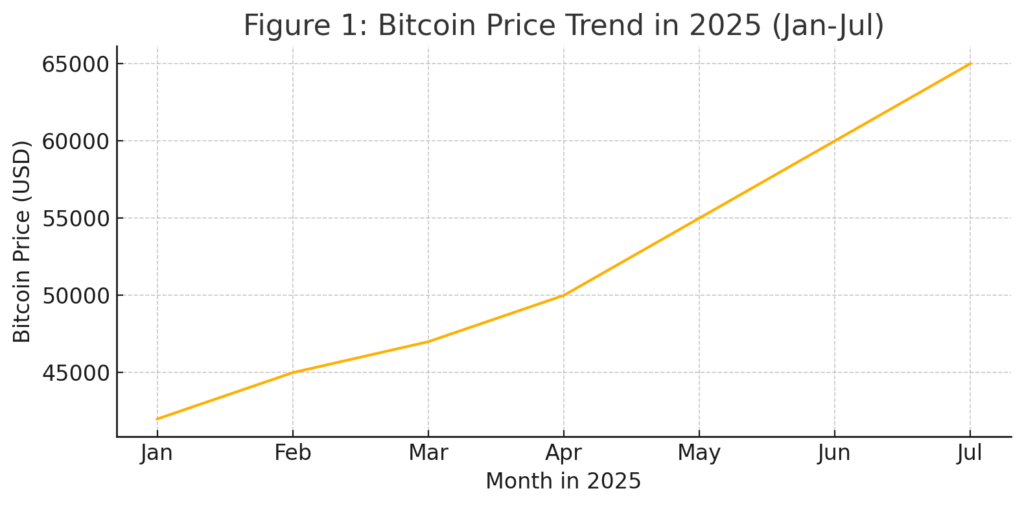
Main Points:
- Elon Musk launches the “America Party” endorsing Bitcoin and challenging fiat currencies.
- The movement pits decentralized cryptocurrencies against entrenched central bank systems.
- Implications for the Japanese yen and Japan’s economic policy are significant.
- Recent trends: rising Bitcoin prices, CBDC developments, and institutional adoption.
- Investors and blockchain practitioners must evaluate new opportunities and risks.
1. Musk’s Political Foray and Bitcoin Endorsement
Elon Musk’s announcement on July 5, 2025 of a new political entity called the “America Party” marked a dramatic entrance into partisan politics. Through his social media platform X, Musk indicated that the party would be “pro-bitcoin,” declaring “Fiat is hopeless, so yes” in response to questions about embracing Bitcoin. This marks a historic moment: for the first time, a major global figure is explicitly tying a political platform to a decentralized cryptocurrency. Tesla’s stock—and by extension Musk’s net worth—suffered a $68 billion drop in market capitalization on the news, underscoring investor concerns about mixing corporate leadership with high-stakes politics.
Musk has long influenced crypto markets; his prior tweets about Dogecoin and Bitcoin have sparked volatile price swings. Now, he is signaling that Bitcoin goes beyond personal investment or speculative asset—it can underpin national policy. If the America Party gains traction, it could catalyze policy proposals at the federal level to integrate Bitcoin into the monetary framework, a prospect that would upend decades of central bank orthodoxy.
2. Battle for the Future of Currency
The America Party’s pro-Bitcoin stance sets up a direct confrontation with central banks, which have traditionally monopolized currency issuance and monetary policy. Fiat currencies like the US dollar and Japanese yen are backed by government decree and managed through tools like interest-rate adjustments, quantitative easing, and reserve requirements. Critics argue these tools can trigger inflation, erode purchasing power, and benefit politically connected institutions over individuals.
Bitcoin, by contrast, operates on a fixed supply cap of 21 million coins and relies on a decentralized network of miners and nodes. Its issuance schedule is algorithmically predetermined, offering transparency and resistance to manipulation. Musk’s critique—that fiat is “hopeless”—resonates with a growing cohort of investors seeking hard money alternatives amid global debt expansion and central bank balance sheet growth.
Should Bitcoin adoption reach a tipping point—through direct government reserves, tax receipts in BTC, or legal tender status—it would force central banks to rethink policy frameworks, potentially adopting crypto-friendly measures or accelerating Central Bank Digital Currency (CBDC) rollouts to maintain relevance.
3. Implications for the Japanese Yen
While the America Party is a US phenomenon, its ripple effects extend to Japan. The yen, long regarded as a safe-haven currency, has endured decades of near-zero interest rates and fiscal stimulus. Japan’s government debt exceeds 250 % of GDP, fueling concerns about future inflation and yen depreciation. Musk’s pro-Bitcoin rhetoric could catalyze Japanese investors to diversify into cryptocurrencies, compounding capital outflows.
Japanese authorities have already piloted a digital yen project, aiming for a CBDC launch by 2027. In May 2025, the Bank of Japan completed Phase 2 tests of the Digital Yen prototype, focusing on technological feasibility . If Bitcoin gains political endorsement elsewhere, Japan may accelerate digital yen development to preserve monetary sovereignty, enhance payment efficiency, and offer a state-backed digital alternative to private cryptocurrencies.
For Japanese corporates and individual investors, the key takeaway is to monitor policy shifts closely, deepen blockchain literacy, and consider Bitcoin as part of a diversified asset allocation—recognizing both its high volatility and its potential as an inflation hedge.
4. Recent Industry Trends
- Bitcoin Price Rally: After a lull in late 2024, Bitcoin surged from around $42,000 in January 2025 to $65,000 by July 2025 (Figure 1). This rally has been fueled by renewed institutional interest, expectations of a Bitcoin ETF approval in the US, and on-chain indicators showing sustained long-term holder accumulation.
- Institutional Adoption: Major financial firms—including BlackRock and Fidelity—have filed for spot Bitcoin ETFs, seeking SEC approval in Q3 2025. A precedent in Canada and Europe suggests these vehicles could attract billions in inflows.
- CBDC Progress: Over 100 countries are exploring CBDCs; Japan, the EU, and China lead pilot phases. Central banks aim to leverage CBDCs for faster cross-border settlements, financial inclusion, and retention of monetary control in an increasingly digital payments landscape.
- Regulatory Developments: The US is pursuing clearer crypto regulations via the proposed “Digital Asset Market Structure Act,” which would classify digital assets under the SEC’s purview. In Japan, amendments to the Payment Services Act are streamlining licensing for crypto exchanges, with new guidelines effective April 2025.
These trends confirm that crypto is transitioning from niche technology to integral financial infrastructure. Investors and blockchain practitioners should review custody solutions, on-chain analytics tools, and compliance frameworks to capitalize on this evolving landscape.

<figure> <center>  <figcaption>Figure 1: Bitcoin Price Trend in 2025 (Jan–Jul)</figcaption> </center> </figure>
Conclusion
Elon Musk’s America Party represents more than a political novelty—it embodies the growing convergence of technology, finance, and governance. By championing Bitcoin, Musk is challenging fiat currency dominance and igniting debate on monetary sovereignty. For Japan, the implications touch on yen stability, CBDC strategy, and investor asset selection. As Bitcoin prices rally and institutions enter the space, stakeholders must balance opportunity with caution—ensuring robust knowledge of blockchain mechanics, regulatory requirements, and market dynamics. The future of finance will likely be hybrid: where decentralized tokens and state-backed digital currencies coexist, reshaping how we transact, invest, and envision economic policy.

